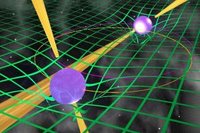 A couple of dead neutron stars that revolve around each other were used by scientists to test Einstein's theory of gravity.
A couple of dead neutron stars that revolve around each other were used by scientists to test Einstein's theory of gravity.The two stars are "dead" and only the dense neutron cores remain of the original stars - but they are heavier and denser than our Sun, with their masses compacted into an area the size of a city! They revolve around each other at a rate of 2.4 million kph, and emit beams of radio waves which make for very precise time-keeping.
Researchers used these stars to see how the radio beams from each star was being delayed (called Shapiro delay) by the other as they passed through each other's space-time.
Some excerpts...
The team found this delay to be close to 90 millionths of a second and the ratio of the observed and predicted values to be 1.0001, plus or minus 0.0005 - a precision of 0.05%.
Other effects were noted as well. For example, whenever one pulsar sits deeper in the gravitational field of the other, its clock appears to run slower. This phenomenon has been observed with atomic clocks flown in aeroplanes above Earth, but in the extreme environment of the pulsars the effect is far more pronounced.
No comments:
Post a Comment